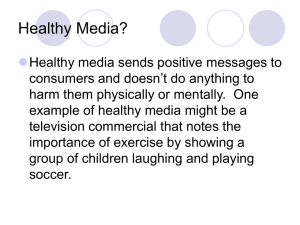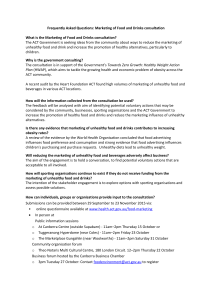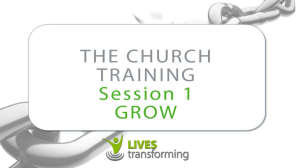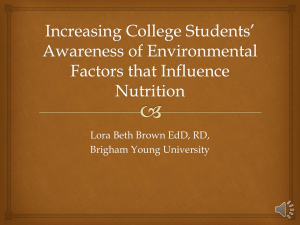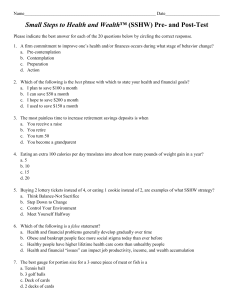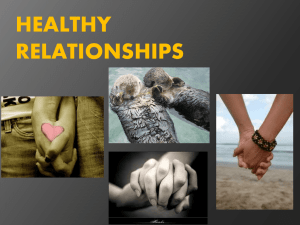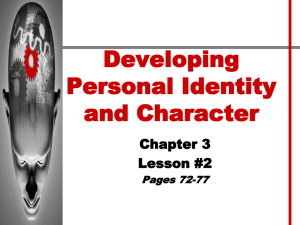File
advertisement
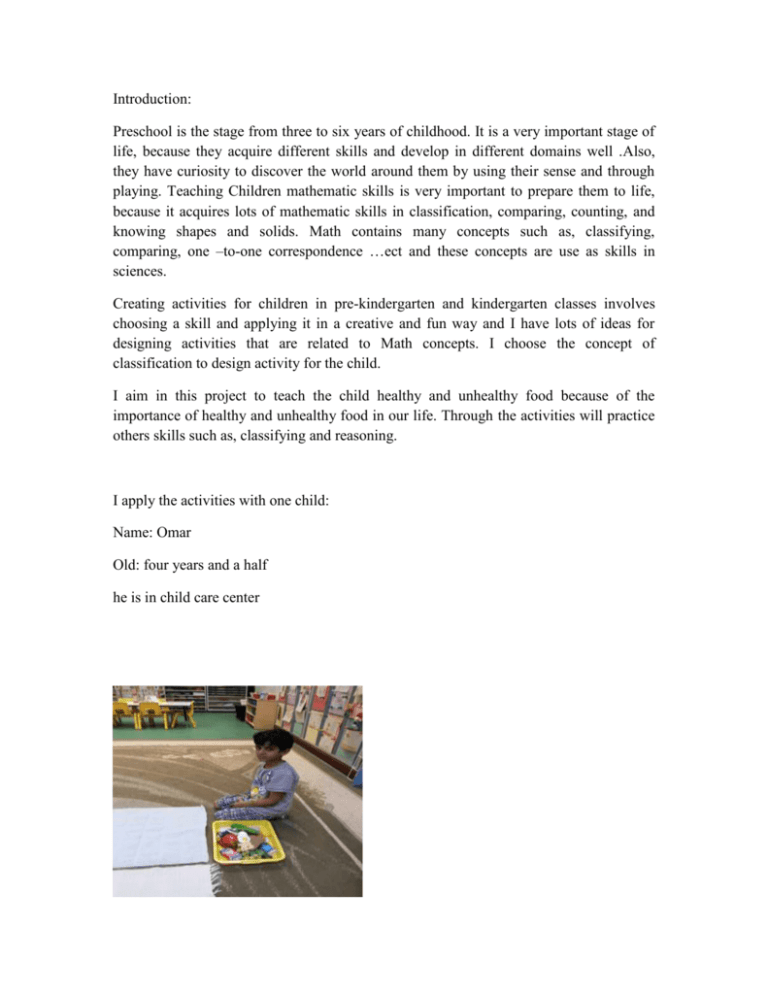
Introduction: Preschool is the stage from three to six years of childhood. It is a very important stage of life, because they acquire different skills and develop in different domains well .Also, they have curiosity to discover the world around them by using their sense and through playing. Teaching Children mathematic skills is very important to prepare them to life, because it acquires lots of mathematic skills in classification, comparing, counting, and knowing shapes and solids. Math contains many concepts such as, classifying, comparing, one –to-one correspondence …ect and these concepts are use as skills in sciences. Creating activities for children in pre-kindergarten and kindergarten classes involves choosing a skill and applying it in a creative and fun way and I have lots of ideas for designing activities that are related to Math concepts. I choose the concept of classification to design activity for the child. I aim in this project to teach the child healthy and unhealthy food because of the importance of healthy and unhealthy food in our life. Through the activities will practice others skills such as, classifying and reasoning. I apply the activities with one child: Name: Omar Old: four years and a half he is in child care center The previous activity (identifying the healthy and UN healthy food): The goal: to ensure that child know the name of fruits and vegetables and unhealthy food such as sweets and chips which are include in the activity and know what is healthy and what is unhealthy before asking him to classify them because without identifying them he cannot classify them . TITLE: healthy food and unhealthy food. DOMAIN: cognitive (science), social skills and language domain. GOAL: Children will identify healthy food and unhealthy food. OBJECTIVE: through this activity, the children will identify healthy food and unhealthy food. He will increase his language skills by knowing new vocabulary of some healthy food such as fruits and vegetables and unhealthy food such as sweets and chips. Moreover, he will be able to decide what they will eat and what is good for him because he identify healthy food and unhealthy food. Also, he will become more comfortable with the social skills because they interact with the teacher. CONTENT: This activity enhances the child vocabulary of healthy and unhealthy food. This activity develops mental skill which is very important in life skills. MATERIALS: - Plastic foods or real foods: fruits, vegetables, ice cream, chips, bread, pizza, cakes, nuts, etc. - Baskets. PROCEDURES: -The teacher tells the child that they have new activity and she tell him the name of the activity. - The teacher asks the child about the name of the objects and if the child doesn’t know she tell him again and he should say after her. -The teacher asks the child randomly about the name of the objects. - Finally she tidy up the activity and tell the child what he will do next. SIMPLIFICATION: Start with few familiar foods to child. Kinds of food that child know them and eat them in their lifelike apple or orange or cookies. EXTENSION: Add many different kinds of healthy and unhealthy food which is not familiar to child. EVALUATION: As the activity progresses throughout the day and weeks, observe the child and take notes about child uses of language. Is he able to identify healthy and unhealthy foods which are in the activity? Ask the child if they know the names of objects. The child should be able to name the objects all of them or at least most of them. Reflection about the field-testing: The child was happy to do the activity, he listen well to the teacher. When the teacher was naming the objects .The child can identify and name all of the objects except the cupcake when the teacher asks him. The second activity is classified healthy food and unhealthy food. DOMAIN: cognitive (science), social skills and language domain. GOAL: Child will classify healthy food and unhealthy food. OBJECTIVE: through this activity, the child will classify healthy food and unhealthy food and he will put all healthy food in one place and the unhealthy food in other place. He will increase his language skills by knowing new vocabularies of food. Moreover, he will be able to think and decide what foods are healthy and what foods are unhealthy. Also, he will become more comfortable with the social skills because he interact with the teacher. CONTANT: This activity meets the child needs of practicing the classifying skills which is very important in his/her academic life later on. This activity enhances the child vocabulary of healthy and unhealthy food. - This activity involves eye-hand coordination which is an important skill in child’s life. MATERIALS: - Plastic foods or real foods: fruits, vegetables, ice cream, chips, bread, pizza, cakes, nuts, etc. - Baskets - Two mats. PROCEDURES: The teacher asks the child about the name of the activity. He should be able to know the name of the object in order to classify the objects in this activity. - The teacher ask each child to classify the object that he has in two mats one for healthy food and the other for unhealthy food. -she helps the child if he need. - the teacher look at the child’s work when he finish and she help the child if he have mistaken and she reinforce the child when he do correct work. - Finally she tidy up the activity and tell the child what he will do next. SIMPLIFICATION: The teacher can put pictures of examples of healthy food and unhealthy food above each mat also the pictures include yes( )in healthy food and no( ) in unhealthy food so, the child when he\she look at the picture it become easy to the child to know what he\she will put on that mat. EXTENSION: Add some foods which are in between healthy and unhealthy food and ask the children to sort them if they are healthy food or unhealthy food or in between. And ask the child to put them between the two mats to show that they are in between healthy and unhealthy food. EVALUATION: Observe the child and take notes about child's uses of language. Is he able to distinguish between healthy food and unhealthy food which are in the activity? Ask the child to classify healthy and unhealthy food he should be able to do that and classify the object which are in the activity all of them or at least most of them. Reflection about the field-testing: The child was happy to do the activity; he can classify most of the objects correctly. He has 2 ages and 2chips in the activity and he but one age on healthy food mat and the other on unhealthy food mat and the same with the 2 chips sol point at one age and I asked him about its name and he said age then I asked him is it healthy or not and he said healthy so l told him if it is healthy where we should put it he smile and take it and put it on the healthy food and the same with the 2 chips. The third activity: reasoning healthy and unhealthy food. TITLE: healthy food and unhealthy food. DOMAIN: cognitive (science), social skills and language domain. GOAL: Child will reason why healthy food is healthy and why unhealthy food is unhealthy. OBJECTIVE: through this activity, the child will know the advantages of healthy food and disadvantages of unhealthy food so he will be able to explain why healthy food is healthy and why unhealthy food is unhealthy. He will increase his language skills by knowing new vocabularies. Such as healthy, unhealthy, oil, fat and sugar. Moreover, he will be able to think what they will eat and what is good for them or bad for them because he knows the advantages of healthy food and disadvantages of unhealthy food. Also, he will become more comfortable with the social skills because they interact with the teacher. CONTANT: This activity enhances the child vocabulary of healthy and unhealthy food. And advantages of healthy food and disadvantages of unhealthy food .Also, this activity develop mental skill like reasoning which is very important in life skills. MATERIALS: - Plastic foods or real foods: fruits, vegetables, ice cream, chips, bread, pizza, cakes, nuts, etc. - Baskets. PROCEDURES: -The teacher asks the child about the name of the activity and she asks the child about the name of the objects in the activity. If the child doesn’t know she tells him again and he should say after her. - The teacher asks the child about the object that he has if it is healthy or unhealthy. -The teacher encourages the child to answer and if the child doesn’t know she tell the child and explain to him by simple words. -The teacher then takes the object from the child and thinks him. - Finally she tidy up the activity and tell the child what they will do next. SIMPLIFICATION: Bring pictures or videos which show the child what is inside the healthy food which make them healthy and what is inside the unhealthy food which makes them unhealthy because child will understand more if they see and listen because as we know children learn by their senses. EXTENSION: A trip can be arranged to a foods factory to see where their food comes from and how they make them and what they put inside them then we ask the children to talk about what they see and know from the trip. EVALUATION: Observe the child and take notes about child's uses of language. Is he able to know the advantages of healthy food and disadvantages of unhealthy food which are in the activity? Ask the child if he knows advantages of healthy food and disadvantages of unhealthy food and ask the child to explain why healthy food is good and unhealthy food is bad? And he should be able to know advantages of healthy food and disadvantages of unhealthy food which are in the activity all of them or at least most of them and give the reason why healthy food is good and unhealthy food is bad? Reflection about the field-testing: The child was happy to do the activity , he can answer the teacher questions about the names of all objects but when the teacher ask him why healthy food is good for example milk he doesn’t know so she told him because it make our mind and body strong. And when the teacher ask the child about unhealthy food and the reason of that for example daunt he doesn’t know the reason of being unhealthy too so I told him because it has lots of sugar and oil. After explain to the child the reason of being healthy food and unhealthy food he understood so when the teacher asked him a gene he can answer and tell the reason but with some help from the teacher. My last reflection about all activities: I like working with Omar because he was smart in doing the activities. I like the activity that I choose. I notice that sequence and repetition were the affective ways to teach children. . Moreover, children need real objects and simple activities to understand well the concept .In addition giving children chance to discover the objects or items at the beginning is very important to understand the concept .Moreover . Omar understand the concept of classification. At the beginning he was know the name of some objects in activity like apple, fish and pizza and so he can’t classify healthy food and unhealthy food also he can’t tell the reason of being healthy food or unhealthy food but after take this activity he is able to identify all the objects in the activity, classify healthy food and unhealthy food correctly and tell the reason of why Healy food is good and unhealthy food is bad by simple words. I think that I have focused on mathematic language which related to the concept while scaffolding and teaching child. Moreover, I should reinforce the child by telling him good or excellent when he answer correctly because that is very necessary to promote the process of learning and encourage the child to work hard. Also, I should give the child more activates to be sure that he understand the concept and can apply it in other activity with other materials. Conclusion: Preparing since activities for children is very interesting and important thing .The child feel happy to do since activity and the teacher should know the level of child to prepare appropriate activity, so the child will be ready and happy to interact with the activity .In addition, learning children the concept classification and reasoning are very important, because we use these concept a lot in our life so the child should know them to be familiar. Sultan Qaboos University Collage of education Early childhood department 2014 Lesson plan (classification concept) Submitted to:D.Azza Habib Done by: seham juma ID: 91422
